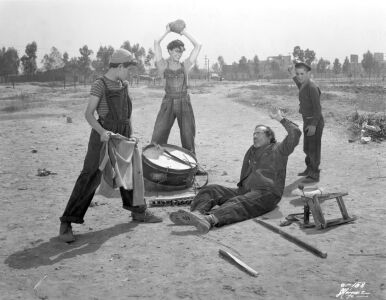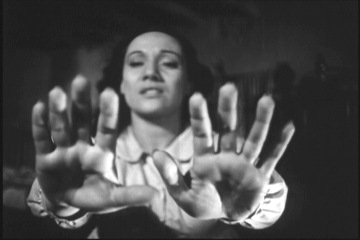1950
Mexico

Don Carmelo: I hope they'll kill every one of them before they born!
On an empty street in Mexico City, a legless man perched on top of a dolly pulls himself along. He is suddenly approached by a posse of gruff young men. The leader of the group asks the poor man for a cigarette. When he refuses, the boys assault him. They tear at his clothes, jettison him to the pavement, and sends his dolly flying down the side of a hill. As the poor man flails around helplessly on the pavement, the youth move on, ignoring his cries for help. Such is the world of Los Olvidados, a gripping film by legendary director Luis Buñuel. By the time the picture has ended, the audiences will have been subjected to one of the harshest stories that the provocative director has ever forced upon the world. It is a story of unflinching honesty and merciless in its execution.
The introduction of the movie informs us that, “Almost every capital like New York, Paris, London hides, behind its wealth, poverty stricken homes where poorly fed children, deprived of health or school are doomed to criminality.” It is these poor children who will be the focus of Buñuel's film. Key among them are Pedro (played by Alfonso Mejía) and an older youth simply known as “El Jaibo” (played by Roberto Cobo). They represent two different ends of the spectrum. Pedro is neglected by his mother who hates him for his behavior. In one scene, after she has refused to feed him when he comes home begging for dinner, she says, “Why should I love you?” So, Pedro must provide for himself in the harsh Mexico City streets. El Jiabo, on the other hand, is an escapee from a juvenile jail and the leader of a street gang. Not only were they responsible for assaulting the legless invalid, they also try to rob a blind street musician. When the initially fail, they track him down after he leaves his perch on the city street, beat him, and destroy his instruments.

Early in the film, El Jiabo locates and murders the person who supposedly snitched on him and got him sent to prison. After killing him, he robs his corpse and shares the money with Pedro, who unfortunately was present during the murder. Now an accessory to the murder, Pedro must live under the constant scrutiny of El Jiabo, who made him swear to keep silent on the murder. After being rejected by his mother, Pedro vows to reform himself and gets a job as a blacksmith's apprentice. However, El Jiabo shows up one day at the blacksmith's shop and steals an expensive knife. Blaming Pedro, the blacksmith sends him to a “farm school,” which in reality is a juvenile rehabilitation program. After a while, Pedro becomes friends with the principal who sends him on an errand with a 50 pesos bill. Once again, El Jiabo shows up and ends up stealing the money. Enraged, Pedro fights El Jiabo and cries out that he was the man who killed the snitch. The conflict continues, and El Jiabo kills Pedro and is then shot by the police.
While it is tempting to dismiss El Jiabo as a regular villain, his relationship with Pedro reveals much more about his character. El Jiabo can be seen as the societal forces that make victims out of children like Pedro. He gets a job, El Jiabo gets him fired. He gets trusted with money, El Jiabo steals it. He tries to do the right thing, El Jiabo kills him. El Jiabo represents every corrupt and sinister part of society that disenfranchises its youngest victims. When he is killed, it does not give the sense that justice has prevailed. Pedro is already dead, his body dumped off a cliff into a landfill, and his mother, having just now realized her love for him, is desperately searching for him. It makes the audience wonder if the only way that Pedro could have been saved was if El Jiabo had not escaped from juvenile prison in the first place.

Buñuel shoots Los Olvidados with a terrifying eye for reality. Before he began shooting, Buñuel researched files from a Mexico City reformatory. He explained, "My film is entirely based on real cases. I tried to expose the wretched condition of the poor in real terms, because I loathe films that make the poor romantic and sweet.” The cast is made up of a combination of professional and non-professional actors, giving the acting a starkly realistic tone. In fact, various elements of the movie, such as the outdoor locations, nonprofessional actors, and a primary focus on society's working classes, are reminiscent of Italian neorealism. However, it is decidedly not in the genre of neorealism.
Buñuel wrote in his 1953 essay, "Poetry and Cinema," “The poetry, the mystery, all that completes and enlarges tangible reality is utterly lacking.” If it is lacking, it is because Buñuel mercilessly cut it out of the final cut. Buñuel was not unfamiliar with the neorealist genre. He had earlier filmed Las Hurdes: Tierra Sin Pan, a documentary about the Las Hurdes region of Spain and their impoverished inhabitants. The most memorable scene would be when a dead baby girl is sent down a river in a basket, eerily reminiscent of the baby Moses story.
But the main reason that Los Olvidados shouldn't be considered a neorealist film is that Buñuel injected a couple of drops of his patented surrealism into the mix. In one scene, an egg is thrown at the camera where is shatters and drips down the screen. Such interaction with the fourth wall would be considered sacrilege for a true neorealist picture. However, the most famous instance of surrealism would be Pedro's dream sequence. It is best summarized by Ed Gonzalez of Slant Magazine:
Pedro's spirit rises from his body and is tortured by the ghost of the dead Julien and his scantily clad mother—all the while, an inexplicable wind claws at her lily-white nightgown. She floats around the room, smothering her son with love and a raw piece of meat that dangles from her hands.
The scene is absolutely captivating. The entire dream is in slow motion and was actually filmed in reverse and switched forward in post-production. This gives the entire sequence an unreal, incorporeal quality that is made all the more startling when contrasted with the rest of the film.

Upon its original release in Mexico, it was received with hostility from local critics who were offended by the portrayal of Mexico's social problems. However, international critics hailed it as a triumph. Buñuel even won the Best Director Award at the 1951 Cannes Film Festival. Today, it is considered the one of Mexico's greatest films. While Buñuel would move on to more sophisticated films concerning the European bourgeoisie, Los Olvidados remains one of his greatest works for its truth and its daring ability to visit the depths of human and societal suffering.

http://www.slantmagazine.com/Film/film_review.asp?ID=270
http://en.wikipedia.org/wiki/Los_Olvidados
http://www.filmreference.com/Films-No-Or/Los-Olvidados.html
http://www.filmschoolrejects.com/features/los-olvidados.php
Hi there. I work for Microcinema International. We curate, exhibit and distribute the moving image arts.
ReplyDeleteI noticed you are a fan of Luis Buñuel...
Big news to share! Luis Buñuel's "Death in the Garden" will be
reviewed in the New York Times! The review should be in the Arts and Entertainment section of this coming Sunday's paper. Be on the look out for it!
Warmest Regards,
Microcinema International
www.microcinemadvd.com
Please check out and join Microcinema on other social networking sites:
Facebook: http://facebook.com/microcinema or http://facebook.com/deathinthegarden
MySpace: http://www.myspace.com/microcinemainternational
Youtube: http://www.youtube.com/microcinema
All right, thank you. Hopefully I can write even more about Buñuel in the future.
ReplyDeleteThông tin chi tiết hơn, ông Đào Anh Tuấn, Tổng giám đốc công ty vận chuyển cho biết, vận tải hàng hóa của đơn vị thue xe tai don nha vẫn chưa đạt kết quả tốt nhưng hành khách thời gian qua tăng khá tuyệt vời với mức hơn 10% so với năm 2016. đặc biệt, doanh thu tăng rất cao, nhất là trong tháng 6 vừa qua tăng hơn 50%.
ReplyDeleteChúng tôi phải áp dụng nhiều giải pháp thue xe tai cho hang tai Ha Noi linh hoạt, trong đó ưu tiên tăng nhanh tàu chạy các chặng ngắn như: Sài Gòn - Phan Thiết, Sài Gòn - Nha Trang. Tháng 5 vừa qua, đưa vào khai thác tuyến mới Nha Trang - Huế và đã đạt 70% hệ số khai thác”, ông Tuấn nói và cho biết, khác biệt, lần trước tiên đường sắt xây dưng chính sách giá vé linh hoạt, khuyến mãi, giảm rét mướt vé cộng đồng, công ty du lịch, hòa hợp nâng chất lượng vệ sinh toa xe, tương tác với khách hàng giá thuê xe tải chở hàng Bình Dương nhiều hơn. “Chính điều này đã hút lượng khách lớn quay quay về với đường sắt, ông Tuấn lý giải.